A Study on Rare Earth Elements Geochemistry of the Makeng Skarn Fe-Mo Deposit and Its Geological Significance in Fujian Province
-
摘要: 马坑铁(钼)矿是一个赋存于莒舟-大洋花岗岩外接触带黄龙组(C2h)灰岩和林地组(C1l)碎屑岩层间构造破碎带中的大型铁矿床。本文利用电感耦合等离子体质谱法(ICP-MS)对马坑的石榴子石、辉石、黄铁矿和磁铁矿矿石的稀土元素(REEs)开展研究。结果表明:石榴子石、辉石和磁铁矿单矿物的稀土分配模式具有相似性,多为轻稀土富集,正铕异常,基本无铈异常,表明其成矿环境为氧化环境,暗示它们之间存在成因联系。矿体附近大理岩和退化蚀变岩稀土元素特征出现规律性变化,表明它们受到岩浆期后热液的交代作用的影响,碎屑岩和褪色辉绿岩提供了部分铁质。Abstract: The Makeng Fe-Mo deposit is a large skarn-type magnetite deposit hosted by interbedded structural fracture zone between limestone in the Huanglong formation (C2h) and clastic rocks in the Lindi formation (C1l) in the vicinity of the outer aureole of the Juzhou-Dayang granite intrusion. The rare earth elements (REEs) in garnet, pyroxene, pyrite and magnetite from the Makeng deposit were studied by Inductively Coupled Plasma-Mass Spectrometry (ICP-MS). The results demonstrate that garnet, pyroxene, pyrite and magnetite have similar chondrite-normalized REEs distribution patterns with light REEs (LREEs) enrichment, moderate Eu positive anomaly and no Ce anomaly. It implies a genetic relation between ores and skarns, which were formed in an oxidation environment. The REEs characteristics of nearby marble and altered rocks varied regularly, which indicates that they were influenced by the metasomatism of post-magmatic hydrothermal fluids, and the ore-forming materials were partially derived from surrounding clastic rocks and diabase.
-
Keywords:
- rare earth elements /
- skarn /
- Makeng Fe-Mo deposit
-
20世纪70年代,高分辨率半导体探测器的问世推动了能量色散X射线荧光光谱(ED-XRF)的发展,相继有了一些采用ED-XRF同时分析组成复杂的地质样品中多种元素的报道[1-5]。ED-XRF技术近年来发展很快,应用领域不断拓展,例如地球化学样品分析[6]、土壤[7-9]、沉积物[10]中的重金属污染调查、月球[11-12]和行星[13]探测、车辆废弃物[14]及在线分析[15]等。
X射线偏振技术在分析仪器中的应用研究始于20世纪70年代末80年代初[16-18],并在90年代开展了一些开拓性的分析应用研究[19-22],证明检出限比普通ED-XRF法改善了约3倍[22]。该技术在国内的应用研究起步较晚,2003年起开始有应用研究文章发表,包括地球化学样品[23-24]、水泥[25]、炉渣[26-27]、卤水[28-29]、土壤[30-31]、铁矿石[32]和生铁[33]等。这些工作中,除卤水分析[28-29]之外,样品制备均采用了粉末压片技术。
上世纪末至本世纪初,随着半导体制作技术、电子技术及计算机技术的飞速发展,特别是微小型X射线管及电致冷半导体探测器的产品化,使小型台式和手持式X射线荧光光谱(P-EDXRF)分析仪快速应用于实验室及野外工作,性能也得到了大幅度提升。这种技术的进步,对地质勘查找矿现场分析工作起到了极大的推动作用,葛良全[3-4]对P-EDXRF的应用进行了比较全面的评述。另一方面,由于X射线荧光分析技术本身是表面-近表面分析技术,进行现场分析时,如果不制备样品,所得结果的正确性会受到样品基体及共存元素谱线干扰的严重影响。为了适应地质找矿工作的需求,作者研究团队自2007年起,开展了以直接粉末制样-小型台式偏振型X射线荧光光谱(PE-EDXRF)分析技术为主体的车载现场分析应用研究[35-36];龙昌玉等[37]采用直接粉末制样-非偏振台式ED-XRF现场快速测定了多金属矿中17种组分;Stark等[7]采用非偏振台式ED-XRF对南极某垃圾处理场的重金属进行了土壤分级测量。采用直接粉末制样法的精度不如玻璃熔片法和粉末压片法高[38],在实验室中使用较少;但对于非矿化或中低矿化度样品的分析,特别是野外现场分析,直接粉末制样法是比较简便实用的制样手段。然而,XRF分析是一种基于比较的分析技术,对于高矿化度或矿石样品,由于存在严重的基体效应而又找不到足够多的基体匹配的校准样品,导致分析数据准确度会受到严重影响,乃至于给出错误的结果,成为制约现场分析高矿化度样品发展的瓶颈。
符斌等[39]通过加入琼脂糖凝固盐酸-硝酸消解得到的锌精矿与铅锌矿样品溶液,采用实验室内波长色散X射线荧光光谱法(WD-XRF)分析了其中的铅、锌、铁元素。这种制样方法既具有溶液法的优点又具有固体法的优点,并且避免了两者固有的缺点。Zhang等[40]同样通过添加凝胶的方式,在实验室内采用WD-XRF法分析了锌精矿中高含量的铅、锌、铁元素。
本文从丰富实验室矿石分析方法出发,针对XRF现场分析高矿化度样品存在的困难和测试过程中可能出现的问题,设计了具有双层聚碳酸酯膜结构的样品盒,开展了酸消解+双层膜液体样品盒强酸性溶液进样、酸消解+缓冲-络合剂近中性溶液进样等系列前处理及进样方法的研究。应用文献[41]与[42]描述的两种样品前处理方法,以双层薄膜样品盒强酸性溶液进样,采用PE-EDXRF技术现场分析青海祁曼塔格高原矿区多金属铜铅锌矿石中的铜、铅、锌三种元素,以期解决现场PE-EDXRF分析高矿化度样品时缺少基体匹配校准标样、粒度效应和矿物效应校正、测试安全等问题。
1. 双层膜液体样品盒研制
1.1 双层膜液体样品盒简介
对于高矿化度矿石、不均匀样品、不规则的金属、合金和陶瓷等,或者某些固体样品难以制备时,溶液法是一种简便有效的制样方法。通过加酸、碱或水等化学手段将试样分解成均匀溶液的方法,这种制样法能够有效地消除粉末或固体的不均匀性与粒度效应,提高具有高矿化度矿石主成分实验数据的精度。在XRF直接溶液法进行测试时,可能会产生气泡、沉淀、析出等现象,而影响测定结果。如果分析易挥发或酸度较高的液体,可能会出现污染或腐蚀仪器的现象。
目前市面上的样品盒[43]是由内套管、外套管、带孔杯盖与单层聚碳酸酯膜构成,难以保证在操作过程中出现的酸性液体泄漏、溶液挥发等现象。王水介质溶液直接用XRF测量的方法,目前尚无报道。本实验针对溶液法在测试过程中可能出现的问题,设计了具有双层聚碳酸酯膜结构的样品盒。图 1是双层膜液体样品盒示意图。双层薄膜结构的样品盒能够有效地阻止液体泄漏,在样品盒顶端增加了可吸附酸气的颗粒状CaO试剂,有效地吸附顶端释放的挥发性酸气。这两种具有双层膜结构的样品盒为ED-XRF的溶液法测试提供了双保险,最大程度地保护了仪器与设备的安全。采用ED-XRF分析技术,照射在样品上的X射线功率低,样品温度几乎不升高,因此样品不会膨胀或在分析面产生气泡,样品盒底膜不会破裂;由于本工作分析对象是重金属元素,总厚度8 μm的双层膜对X射线荧光强度的影响不显著。
1.2 双层膜液体样品盒的制作
双层膜液体样品盒主要是由内、中、外套管和杯盖四部分构成。将第一层4 μm聚碳酸酯膜固定在内套管与中套管之间,第二层4 μm聚碳酸酯膜固定在中套管与外套管之间,内、中、外套管底部均与聚碳酸酯薄膜处于同一水平位置,用于盛放液体样品。将一定体积溶液移取至双层膜样品盒内,盖上杯盖(或附上带有吸附剂的杯盖),即制作出一个具有双层膜结构的液体样品盒。
2. 偏振能量色散X射线荧光光谱分析
2.1 仪器及工作条件
XEPOS型台式偏振激发能量色散X射线荧光光谱仪(德国Spectro公司)。仪器配备:Pd靶X射线光管,最高电压50 kV,最大电流2 mA,最大功率50 W;硅漂移探测器,铍窗厚度15 μm,能量分辨率148 eV (5.9 keV处),电致冷;具备钼、高定向热解石墨(HOPG)、Al2O3、钯、锆、锌、铈、钴等8种二级靶。本实验选用钼二级靶,多道分析器选择2048道,测量能量范围为0~25 keV,工作条件:管流0.88 mA,管压40 kV,测量时间200 s。
野外仪器电源是由发电机供给UPS,UPS稳定电压后再供给仪器。
2.2 标准溶液和主要试剂
铜标准溶液(5 mg/mL):10%硝酸介质,中国计量科学研究院国家标准物质研究中心产品。
铅标准溶液(5 mg/mL):10%硝酸介质,中国计量科学研究院国家标准物质研究中心产品。
锌标准溶液(5 mg/mL):10%硝酸介质,中国计量科学研究院国家标准物质研究中心产品。
硝酸(BVⅢ级,北京化学试剂研究所),盐酸 (BVⅢ级,北京化学试剂研究所)。
高纯水:蒸馏水由Mili-Q纯化系统纯化,电阻率为18 MΩ·cm。
王水(50%):由三体积的盐酸与一体积的硝酸混合后,与四体积的高纯水充分混合均匀,现用现配。
2.3 校准样品制备及方法校准
2.3.1 混合标准溶液的制备
分别移取一定体积的铜、铅、锌标准溶液于25 mL玻璃容量瓶内,用高纯水定容至刻度,混合均匀后静置备用。共配制6份,其中第一份是空白溶液,对应样品编号的溶液内各元素的浓度值见表 1。
表 1 标准溶液中各元素的浓度Table 1. Concentration of the elements in calibration standard solutions标准溶液编号 ρ/(μg·mL-1) Cu Pb Zn 标准溶液1 0 0 0 标准溶液2 200 100 50 标准溶液3 100 50 20 标准溶液4 50 20 10 标准溶液5 20 10 5 标准溶液6 10 5 200 2.3.2 铅铜锌分析谱线的选择
钼靶的Kα特征谱线对Pb的L壳层电子具有特定的选择激发效应,一般选择钼靶作为测定铅的激发源。铅锌矿往往含有砷,As的Kα线(10.530 keV)几乎与Pb的Lα1线(10.550 keV)完全重叠,谱线干扰严重,并且相同含量的As Kα线强度为Pb Lα1线的二倍多。所以当矿石中铅的含量较低时,即使砷的含量仅仅只有1‰,也会对Pb Lα1产生相当严重的干扰,影响也非常显著。为克服As Kα对Pb Lα的干扰,本研究选择Pb的Lβ作为分析谱线。在测定过程中几乎不存在铜、锌的干扰因素,选择其最灵敏线Kα作为铜、锌的分析谱线。
2.3.3 方法校准
以表 1中的混合标准溶液作为校准样品。按本文2.1节选定的分析条件建立分析方法并对各标准溶液进行测量,采用二级靶Mo Kα线的康普顿散射内标校正基体效应。样品经混合定容,不同样品的基体趋于一致,满足康普顿散射对分析轻基体中重元素的要求。Cu、Pb、Zn三种校准元素的标准曲线均呈现良好的线性关系,线性相关系数均达0.9999及以上。标准曲线见图 2。
溶液样中的铜铅锌元素均稀释400倍,故本方法的稀释倍数为400倍,即样品测量值均是溶液内实际浓度值乘以稀释倍数的数据。
2.4 样品制备
文献[41, 43-44]报道了应用王水消解结合电感耦合等离子体光谱/质谱分析地质样品。温宏利等[41]采用王水溶样-电感耦合等离子体发射光谱法同时测定铁铜铅锌矿石中Cu、Pb、Zn、As、Ag、Cd、Hg、Mo等8个元素,分析GBW 07162~GBW 07168国家标准物质得到大部分元素的相对标准偏差(RSD)小于5%且相对误差小于10%。原地质矿产部制定的岩石和矿石分析规程DZG 93-01[42]中,分析地质样品中铜、铅、锌量的操作步骤是:先后顺序添加盐酸与硝酸试剂,根据实际样品中测量元素含量情况,选择添加盐酸或硝酸提取。
本文采用文献[41]与[42]的方法,进行样品前处理操作。两种样品前处理的实验步骤如下。
2.4.1 水浴加热+王水在比色管中消解样品
准确称取烘干后的试样0.1000 g于25 mL比色管内,加入新配制的50%王水10 mL,倾斜地放置塞子于比色管管口,在沸水水浴中分解样品2 h后,取下比色管,冷却至室温后,直接用高纯水定容至刻线25 mL处,盖紧盖摇匀,静置待测。空白与样品制备方法相同。简称为方案1。
2.4.2 电热板加热+盐酸、硝酸顺序消解+硝酸提取
准确称取烘干后的试样0.1000 g于100 mL玻璃烧杯内,用水润湿,加入15 mL盐酸,盖上表面皿,放置电热板上低温加热3~5 min,除去大部分的硫化氢,加入5 mL硝酸,继续加热至200℃使试样分解完全。用少量水洗去表面皿,蒸发至近干。用2 mL硝酸溶解残渣,高纯水冲洗杯壁,至总体积约为15 mL。继续加热至溶液清澈,冷却,转至比色管内,用高纯水定容至25 mL刻度,摇匀,静置待测。空白与样品制备方法相同。简称为方案2。
2.5 溶液样品测定
准确移取5 mL澄清溶液于双层膜溶液样品盒,盖上杯盖,静置在洁净干燥的滤纸一段时间后,然后放入仪器配备的样品盒容器内,将样品盒容器与样品杯一起放入仪器样品室内载样盘的指定位置。为避免液体意外泄漏可能对仪器的损坏,每次仅放入一个待测样品且放置在样品盘2号位置。选择本文2.3节中建立的分析方法,进行测量。测试完毕,测试样连同样品盒容器一道取出。
3. 结果与讨论
3.1 双层膜液体样品盒的可行性探讨
为模拟仪器工作状态,将内盛放一定体积的待测溶液的双层膜液体样品盒,放置在一个封闭的空间内,并且在样品盒周围等距离位置分别放置润湿pH试纸。24 h之后,pH试纸均未变色,样品盒内溶液未出现漏泄现象。放置一周后,样品盒的内层样品盖上出现有极少量液滴附着,pH试纸仍未发生明显颜色变化,样品盒溶液无明显泄漏现象。将9组盛装待测溶液的双层膜液体样品盒放置在该封闭空间内,放置半年,用于放置样品盒的滤纸有一个出现少许溶液的痕迹,其余双层样品盒底部的聚碳酸酯膜变得更加柔软,且均未出现破裂的现象。为避免酸性介质的溶液对聚碳酸酯膜的缓慢腐蚀,测量时间不宜过长,测量完毕应该立即取出样品盒。本实验中,使用的PE-EDXRF功率为50 W,采用具有所述双层膜结构的样品盒分析了近百件高酸度液体样品,其中最长测量时间为600 s,未发现液体泄漏情况,说明该样品盒能够满足实际测试要求。
需要明确的是,这两种双层膜液体样品盒是为ED-XRF分析重金属元素设计的。本工作未对所述双层膜液体样品盒在WD-XRF仪器上的使用情况进行研究。由于高功率WD-XRF光谱仪对样品的辐照很强,特别是在以酸度较高的样品进样时,本文所述的双层膜液体样品盒使用的安全性和适用性会降低。
3.2 样品酸溶方式的比较
3.2.1 两种酸溶方式测定质量监控管理样和未知样品
采用方案1(水浴加热)与方案2(电热板加热)两种酸溶样品方式,对编号为81MS01、81MS02、81MS10、81MS12的4件地质样品进行前处理,这4件样品是青海省地质矿产测试应用中心实验室用来进行例行分析质量监控的管理样品。使用现场车载PE-EDXRF进行分析,测量结果与参考值列于表 2。从表 2的数据可以得到,与方案1测量数据进行比较,方案2的测量数据更接近参考值,对于含量在5‰以上的Cu、Zn、Pb,方法准确度均优于5%,测定结果能够令人满意。
表 2 质量监控管理样的测量数据Table 2. Analytical results of Cu,Pb,Zn in quality control samples by PE-EDXRF样品编号 w(Cu)/% w(Pb)/% w(Zn)/% 参考值 方案1 方案2 参考值 方案1 方案2 参考值 方案1 方案2 81MS01 0.51 0.43 0.51 0.045 0.08 0.10 0.14 0.13 0.15 81MS02 1.57 1.28 1.52 0.084 0.09 0.11 0.78 0.67 0.78 81MS10 0.012 0.008 0.013 4.20 3.58 4.02 0.80 0.67 0.78 81MS12 0.010 0.010 0.010 0.52 0.46 0.53 4.86 4.19 4.98 在祁曼塔格矿区现场对编号为QMTG 15与QMTG 85的两种未知矿石样品,采用方案1和方案2分别进行10次重复取样、消解分析测定,得到的实验精密度统计见表 3~表 5。由表 3~表 5可以看出,采用方案1的精密度较差,特别是Pb含量较高的样品,可能是由于样品消解不完全所致。采用方案2,除了一个样品Zn含量的较低外,其他元素的精密度(RSD,n=10)均小于2%。方案2的测量数据更接近参考值。
表 3 测量铜元素的精密度Table 3. Analytical precision for Cuw(Cu)/% QMTG 15 QMTG 85 方案1 方案2 方案1 方案2 参考值 4.79 4.79 8.45 8.45 平均值 4.21 5.03 7.17 8.39 RSD/% 3.75 1.82 2.40 1.08 表 4 测量铅元素的精密度Table 4. Analytical precision for Pbw(Pb)/% QMTG 15 QMTG 85 方案1 方案2 方案1 方案2 参考值 23.1 23.1 2.21 2.21 平均值 21.4 23.2 1.90 2.15 RSD/% 5.80 1.51 1.85 1.93 表 5 测量锌元素的精密度Table 5. Analytical precision for Znw(Zn)/% QMTG 15 QMTG 85 方案1 方案2 方案1 方案2 参考值 0.28 0.28 1.19 1.19 平均值 0.22 0.27 0.94 1.10 RSD/% 4.86 2.13 1.92 1.39 3.2.2 两种酸溶方式测定祁曼塔格矿区实际样品
在现场车载实验室,对祁曼塔格矿区13件地质样品进行分析,实验数据列于表 6。其中,方案1与方案2实验数据均由车载偏振激发ED-XRF仪器现场检测;AAS是现场原子吸收分光光度法的测量数据。
表 6 现场样品测量数据的比较Table 6. Analytical results of elements in different samples analyzed by different digestions样品编号 w(Cu)/% w(Pb)/% w(Zn)/% 方案1 方案2 AAS 方案1 方案2 AAS 方案1 方案2 AAS QMTG 14 2.09 2.50 2.38 17.0 19.4 19.3 0.16 0.21 0.22 QMTG 15 4.14 5.12 4.79 20.3 23.4 23.1 0.21 0.27 0.28 QMTG 16 2.52 2.92 3.04 4.94 5.48 5.54 0.11 0.12 0.15 QMTG 17 2.14 2.18 2.20 25.8 29.1 31.3 0.18 0.24 0.26 QMTG 20 1.43 1.74 1.58 2.36 2.74 2.50 0.11 0.13 0.15 QMTG 47 0.66 0.75 0.76 4.31 4.73 4.74 0.09 0.11 0.12 QMTG 56 2.08 2.53 2.58 3.40 3.97 4.03 1.28 1.54 1.60 QMTG 71 3.68 4.38 4.49 1.66 1.88 1.91 0.59 0.69 0.75 QMTG 75 2.62 3.18 3.19 1.38 1.64 1.63 0.98 1.19 1.24 QMTG 84 4.70 5.69 5.69 0.66 0.78 0.78 1.26 1.55 1.58 QMTG 85 7.23 8.57 8.45 1.91 2.00 2.21 0.95 1.13 1.19 QMTG 86 3.35 4.00 4.11 1.37 1.55 1.61 1.24 1.47 1.57 QMTG 90 6.22 7.18 7.16 2.34 2.62 2.62 2.16 2.51 2.57 方案1的实验数据wPE-EDXRF与AAS测量数据wAAS进行线性拟合得到以下结果。
Cu相关系数0.9977,线性方程:
wAAS=1.1753×wPE-EDXRF+0.0035
Pb相关系数0.9991,线性方程:
wAAS=1.1807× wPE-EDXRF-0.1503
Zn相关系数0.9993,线性方程:
wAAS=1.2048× wPE-EDXRF+0.0347
方案2的实验数据wPE-EDXRF与AAS测量数据wAAS进行线性拟合得到以下结果。
Cu相关系数0.9984,线性方程:
wAAS=0.9882× wPE-EDXRF+0.0213
Pb相关系数0.9986,线性方程:
wAAS=1.0365× wPE-EDXRF-0.1265
Zn相关系数0.9997,线性方程:
wAAS=1.0250× wPE-EDXRF+0.0186
由表 6实验数据与结果的比较可以得到,采用水浴加热、王水酸溶样品的方案1,配合使用同一样品盒建立的PE-EDXRF分析测试方法,在海拔四千多米以上的地区,由于空气稀薄压力较低,实验水浴的实际温度约为88℃,不足以提供快速酸消解矿石的条件,导致部分样品消解不完全,元素的测定结果系统偏低。采用方案2的电热板加热、盐酸+硝酸溶解样品PE-EDXRF分析的数据与原子吸收分光光度法(AAS)分析结果比较,得到平均相对偏差:Cu为 2.87%(含量范围在0.75%~8.57%),Pb为 2.82%(含量范围在0.78%~29.1%),Zn为6.84%(含量范围在0.11%~2.51%)。
以上对实验室管理样及未知样品开展的车载实验室现场分析表明,当采用方案2消解样品时,样品消解完全,Cu、Pb、Zn含量在5‰以上的管理样品的分析相对误差均优于5%,相对标准偏差(RSD,n=10) < 2.0%,未知样品分析结果与AAS法分析结果具有很好的一致性。采用方案2的样品消解方案,配合使用双层膜溶液样品盒建立的PE-EDXRF分析测试方法,能够很好地解决高矿化度样品及矿石样品的较高精度现场分析问题。
4. 结语
通过标准溶液的校准与矿石样品酸消解溶液样品的制备,实现了矿石样品中高品位铜、铅、锌元素的PE-EDXRF准确分析,解决了多金属矿石复杂基体样品PE-EDXRF分析时缺少基体匹配校准标样、粒度效应和矿物效应校正困难的问题,使矿石样品EDXRF分析的可靠性大幅度提高。采用PE-EDXRF分析技术,使用研制的专利双层膜液体样品盒,照射在样品上的X射线功率低,样品不会因温度升高而在分析面产生气泡,或出现样品盒底膜破裂,确保了PE-EDXRF分析酸性液体样品的安全性。
通过在祁曼塔格矿区现场对实验室管理样及未知样品开展的车载实验室现场分析表明,采用电热板加热的样品消解方案,配合使用双层膜溶液样品盒建立的PE-EDXRF分析测试方法,能够很好地解决高矿化度样品及矿石样品的较高精度现场分析问题。
本研究使车载PE-EDXRF分析矿石样品的能力得到显著改善,与AAS技术的现场分析技术相比,所述方法具有不需要燃气等辅助材料等突出优点,能够为多金属矿石样品的现场分析提供快速、准确、安全、低污染的解决方案,同时对作者团队已形成的中低矿化度样品的粉末制样-车载PE-EDXRF现场分析技术是一个很好的补充和完善。
致谢: 论文撰写过程中得到了中国地质科学院矿产资源研究所毛景文研究员、杨富全研究员、谢桂青研究员、张作衡研究员,马坑矿业公司总经理姜益丰、总工程师陈宁青和任浩、刘武刚、王金祥等同志的指导和帮助,特致谢枕! -
图 3 马坑铁矿床岩石、矽卡岩、蚀变岩和矿物稀土元素的分配模式
A—莒舟、大洋花岗岩的REEs分配模式;B—辉绿岩的REEs分配模式;C—石榴子石、辉石单矿物的REEs分配模式;D—磁铁矿单矿物的REEs分配模式;E—石英磁铁矿、方解石磁铁矿石的REEs分配模式;F—黄铁矿单矿物的REEs分配模式;G—大理岩的REEs分配模式;H—钾长岩、石英砂岩、石英岩的REEs分配模式;I—莒舟、大洋花岗岩内磁铁矿单矿物的REEs分配模式。
Figure 3. Chondrite-normalized REEs patterns of rocks,ores and minerals from Makeng deposit
表 1 马坑铁矿岩体、矽卡岩、矿石和蚀变岩稀土元素组成
Table 1 REEs analytical results and related characteristic values of rock mass, skarn, ores and related rocks in Makeng deposit

-
赵一鸣,谭惠静,许振南.闽西南地区马坑式钙矽卡岩型铁矿床[J].中国地质科学院矿床地质研究所所刊,1983,1(1): 1-141. http://cpfd.cnki.com.cn/Article/CPFDTOTAL-ZGDJ198300007002.htm 韩发,葛朝华.福建马坑铁矿床海相火山热液-沉积成因-地质地球化学特征[J].中国地质科学院矿床地质研究所所刊,1983,1(2): 1-118. http://cpfd.cnki.com.cn/Article/CPFDTOTAL-ZGDJ198612001076.htm 张承帅.福建马坑铁钼多金属矿床地质特征研究[J].矿床地质,2010,29(Z1): 123-124. http://www.cnki.com.cn/Article/CJFDTOTAL-KCDZ2010S1067.htm 陈述荣,谢家亨,许超南,郭维伍.福建马坑铁矿床成因的探讨[J].地球化学,1985,82(4): 350-357. http://www.cnki.com.cn/Article/CJFDTOTAL-DQHX198504007.htm 梁祥济,曲国林.福建马坑铁矿床形成温度和压力实验的初步研究[J].中国地质科学院院报, 1982,4(1): 83-94. http://cpfd.cnki.com.cn/Article/CPFDTOTAL-ZGDJ198200012009.htm 赵一鸣,林文蔚,毕承思.中国矽卡岩矿床[M].北京: 地质出版社,1990: 164-171. 毛景文.桂北BT锡矿稀土元素特征及其与成矿的关系[J].河北地质学院学报,1987,10(3): 273- 287. http://www.cnki.com.cn/Article/CJFDTOTAL-HBDX198703003.htm 邱瑞龙.贵池铜山铜矿矽卡岩稀土元素地球化学[J].地质学报,1987,61(1): 91- 100. http://www.cnki.com.cn/Article/CJFDTOTAL-DZXE198701008.htm 王中刚,于学元,赵振华.REE稀土元素地球化学[M].北京: 科学出版社,1989: 1-535. 陈骏.柿竹园矽卡岩型钨锡钼铋矿床主要造岩矿物中REE的分布特征及成岩意义[J].地球化学,1994(Z1): 84-92. doi: 10.3321/j.issn:0379-1726.1994.z1.011 吴言昌.论岩浆矽卡岩——一种新类型矽卡岩[J].安徽地质,1992,2(1): 12-26. http://www.cnki.com.cn/Article/CJFDTOTAL-AHDZ199201002.htm 赵斌,赵松,刘海臣.长江中下游若干Cu (Au), Cu-Fe(Au)和Fe矿床中钙质矽卡岩的稀土元素地球化学[J].地球化学,1999,28(2): 113-125. http://www.cnki.com.cn/Article/CJFDTOTAL-DQHX902.001.htm 肖成东,刘学武.东蒙地区矽卡岩石榴子石稀土元素地球化学及其成因[J].中国地质,2002,29(3): 311-316. http://cdmd.cnki.com.cn/Article/CDMD-10533-1014145010.htm 凌其聪,刘丛强.层控矽卡岩及有关矿床形成过程的稀土元素行为——以安徽冬瓜山矿床为例[J].岩石学报,2002,19(1): 192-200. 王莉娟,王京彬,王玉往,岛崎英彦.内蒙黄岗梁矽卡岩型铁锡矿床稀土元素地球化学[J].岩石学报,2002,18(4): 575-584. http://www.cnki.com.cn/Article/CJFDTOTAL-YSXB200204016.htm 贾润幸,方维萱,赫英,高振敏,李红阳.个旧超大型锡多金属矿稀土元素地球化学特征[J].中国稀土学报,2005,23(2): 228-234. http://www.cnki.com.cn/Article/CJFDTOTAL-XTXB200502023.htm 梁婷,王登红,屈文俊,蔡明海,韦可利,黄惠民,吴德成.广西大厂锡多金属矿床方解石的REE地球化学特征[J].岩石学报,2007,23(10): 2493-2503. doi: 10.3969/j.issn.1000-0569.2007.10.017 杨富全,毛景文,徐林刚,张岩,刘锋,黄成林,周刚,刘国仁,代军治.新疆蒙库铁矿床稀土元素地球化学及对铁成矿作用的指示[J].岩石学报,2007,23(10): 2443-2456. doi: 10.3969/j.issn.1000-0569.2007.10.013 赵劲松,邱学林,赵斌,涂湘林,虞珏,芦铁山.大冶-武山矿化矽卡岩的稀土元素地球化学研究[J].地球化学,2007,36(4): 400-412. http://www.cnki.com.cn/Article/CJFDTOTAL-DQHX200704010.htm 徐晓春,赵丽丽,谢巧勤,褚平利,房海波,王文俊.铜陵狮子山矿田金矿床和铜矿床矿石稀土元素地球化学[J].高校地质学报,2009,24(1): 35-47. http://www.cnki.com.cn/Article/CJFDTOTAL-GXDX200901003.htm 张志欣,杨富全,柴凤梅,刘锋.新疆阿尔泰乌吐布拉克铁矿床稀土元素地球化学研究[J].矿床地质,2010,30(1): 83-101. http://www.cnki.com.cn/Article/CJFDTOTAL-KCDZ201101009.htm 吴凎国,张达,陈柏林,吴建设.中国东南大陆中生代构造域的转换及其与成矿的关系——以闽西南地区为例[J].地质科学,2000,25(4): 390-396. http://www.cnki.com.cn/Article/CJFDTOTAL-DQKX200004011.htm 毛建仁,陶奎元,谢芳贵.闽西南地区成岩成矿作用与构造环境[J].岩石矿物学杂志,2001, 20(3): 329-336. http://www.cnki.com.cn/Article/CJFDTOTAL-YSKW200103015.htm 毛景文,谢桂青,程彦博.华南地区中生代主要金属矿床模型[J].地质论评,2009,55(3): 346-354. http://www.cnki.com.cn/Article/CJFDTOTAL-DZLP200903007.htm 毛建仁,陈荣,李寄隅,叶海敏,赵希林.闽西南地区晚中生代花岗质岩石的同位素年代学、地球化学及其构造演化[J].岩石学报,2006,22(6): 1723-1734. http://www.cnki.com.cn/Article/CJFDTOTAL-YSXB200606029.htm 毛建仁,许乃政,胡青.福建省上杭-大田地区中生代成岩成矿作用与构造环境演化[J].岩石学报,2004,20(2): 285-296. http://www.cnki.com.cn/Article/CJFDTOTAL-YSXB200402009.htm 张达.闽西南地区构造演化与锡多金属区域成矿作用[D].北京: 中国地质科学院,1999: 1-145. 李萌清,陈伟十.马坑铁矿流体包裹体研究及成矿作用探讨[J].中国地质科学院矿床地质研究所所刊,1983,1(1): 91-101. http://cpfd.cnki.com.cn/Article/CPFDTOTAL-ZGDJ198209001009.htm 张承帅,苏慧敏,于淼,胡兆国.福建龙岩大洋-莒舟花岗岩锆石U-Pb年龄和Sr-Nd-Pb同位素特征及其地质意义[J].2012,28(1): 225-242. 罗铭玖,张辅民,董群英,许永仁,黎世美,李昆华.中国钼矿床[M].郑州: 河南科学技术出版社,1991: 155-163. 葛朝华,韩发.马坑铁矿床稀土元素地球化学研究[J].矿床地质,1984,3(1): 1-10. http://www.cnki.com.cn/Article/CJFDTOTAL-KCDZ198401000.htm Whitney P R, Olmsted J F. Rare earth element metaso-matism in hydrothermal systems: The Willsboro-Lewis wollastonite ores, New York, USA[J]. Geochimica et Cosmochimica Acta,1998,62(17): 2965-2977. doi: 10.1016/S0016-7037(98)00230-0
Miguel G, Charles K, Lawrence M, Roberto M. REE in skarn systems: A LA-ICP-MS study of garnets from the Crown Jewel gold deposit[J]. Geochimica et Cosmochimica Acta,2008, 72: 185-205. doi: 10.1016/j.gca.2007.09.033
丁振举,刘丛强,姚书振,周宗桂,杨明国.东沟坝多金属矿床矿质来源的稀土元素地球化学限制[J].吉林大学学报: 地球科学版,2003,33(4): 437-442. http://www.cnki.com.cn/Article/CJFDTOTAL-CCDZ200304009.htm 丁振举,刘丛强,姚书振,周宗桂.海底热液沉积物稀土元素组成及其意义[J].地质科技情报, 2000,19(1): 27-30,34. http://www.cnki.com.cn/Article/CJFDTOTAL-DZKQ200001006.htm 丁振举,刘丛强,姚书振.海底热液系统高温流体的稀土元素组成及其控制因素[J].地球科学进展,2000,15(3): 307-312. http://www.cnki.com.cn/Article/CJFDTOTAL-DXJZ200003012.htm Joseph L G. Rare earth elements as hydrothermal tracers during the formation of massive sulfide deposits in volcanic rocks[J].Economic Geology,1977,77(4): 527-548.
沈其韩,宋会侠,赵子然.山东韩旺新太古代条带状铁矿的稀土和微量元素特征[J].地球学报,2009,30(6): 693-699. http://www.cnki.com.cn/Article/CJFDTOTAL-DQXB200906004.htm 余金杰,毛景文.宁芜玢岩铁矿磷灰石的稀土元素特征[J].矿床地质,2002,21(1): 65-73. http://www.cnki.com.cn/Article/CJFDTOTAL-KCDZ200201011.htm 王登红,李华芹,陈毓川,屈文俊,梁婷,应立娟,韦可利,刘孟宏.桂西北南丹地区大厂超大型锡多金属矿床中发现高稀土元素方解石[J].地质通报,2005,24(2): 176-180. http://www.cnki.com.cn/Article/CJFDTOTAL-ZQYD200502014.htm 毕献武,胡瑞忠,彭建堂,吴开兴.黄铁矿微量元素地球化学特征及其对成矿流体性质的指示[J].矿物岩石地球化学通报,2004,23(1): 1-4. http://www.cnki.com.cn/Article/CJFDTOTAL-KYDH200401001.htm Lottermoser B G. Rare-earth elements and hydrothermal ore formation processes[J].Ore Geology Reviews,1992,7: 25-41. doi: 10.1016/0169-1368(92)90017-F
赵振华.微量元素地球化学[M].北京: 科学出版社,1997: 1-153. Anders E, Grevess N. Abundances of the elements: Meteoritic and solar[J]. Geochimica et Cosmochimica Acta,1989,53: 197-214. doi: 10.1016/0016-7037(89)90286-X
杨耀民,涂光炽,胡瑞忠.迤纳厂稀土铁铜矿床稀土元素地球化学[J].矿物学报,2004, 24(3): 301-308. http://www.cnki.com.cn/Article/CJFDTOTAL-KWXB200403015.htm 张承帅.福建马坑铁矿床地质与地球化学[D].北京: 中国地质大学(北京),2012: 1-200.




 下载:
下载:

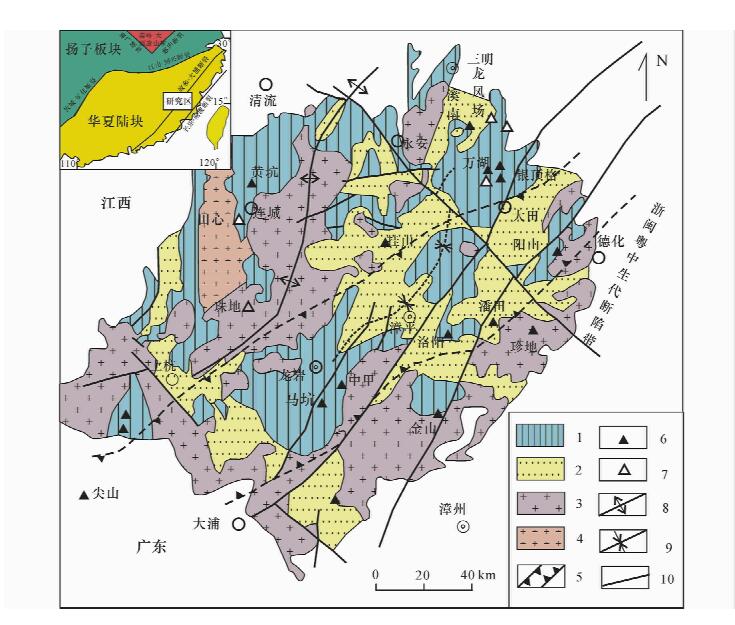
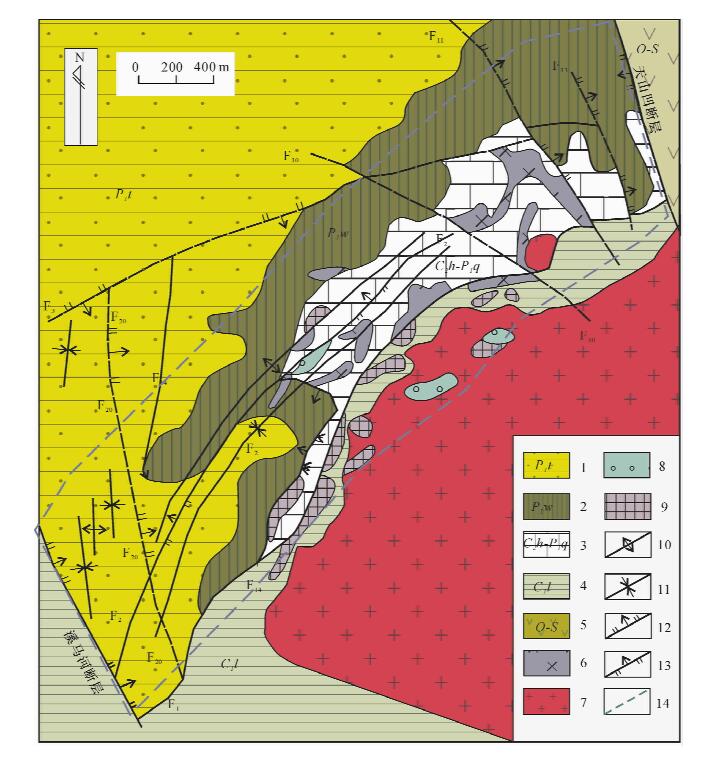
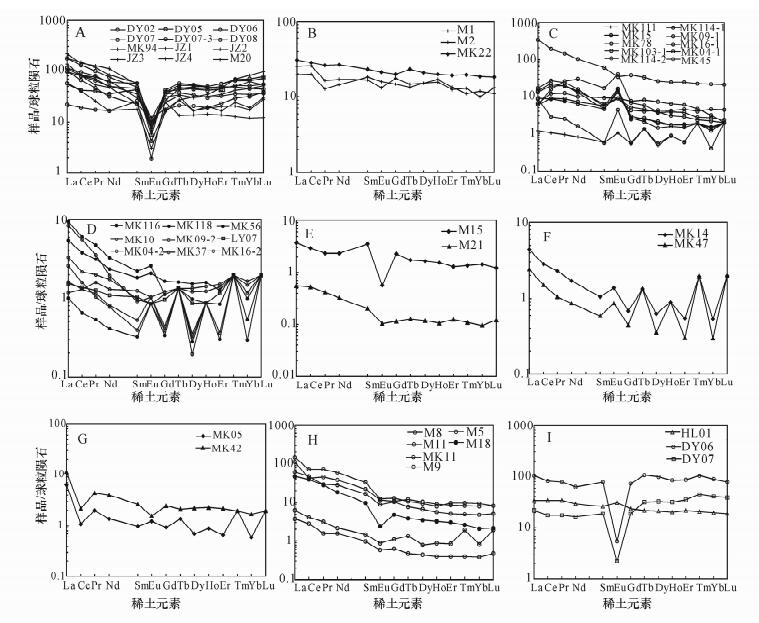
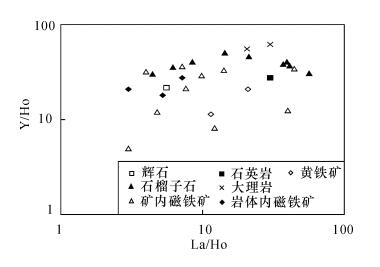
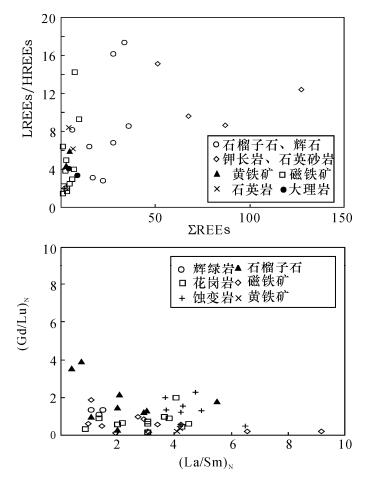
 京公网安备 11010202008159号
京公网安备 11010202008159号